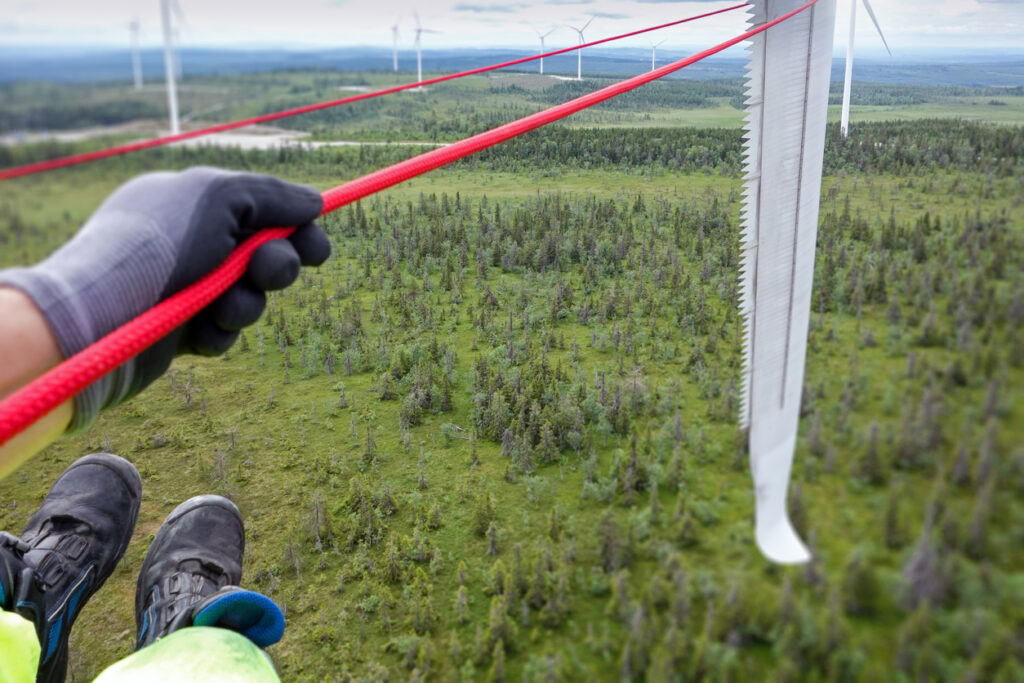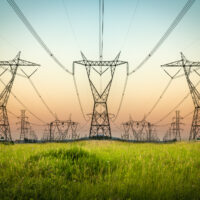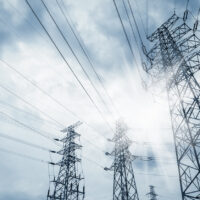
This case study was co-produced with Canada Grid, an initiative of The Transition Accelerator.
Introduction
In its pursuit of carbon neutrality by 2050, Denmark has become one of the world’s leading producers of variable renewable energy, with wind power alone accounting for 47 per cent of its domestic supply in 2021. What made that impressive achievement possible, however, was robust connections with other Nordic jurisdictions that can supply power when the wind isn’t blowing. These jurisdictions also provide a market for surplus Danish supply when generation is strong.
For more than 25 years, Denmark has worked with its neighbours Norway, Sweden, and Finland to build a market of two-way trade that facilitates cost efficiency, flexibility, and carbon emission reduction. The inter-jurisdictional co-operation has since expanded to the Baltic states of Latvia, Estonia, and Lithuania, and increasingly with European Union neighbours.
The experience of the Nordic countries holds some key lessons for Canadian provinces that are facing decarbonization challenges.
Electricity trade, the Nordic experience shows, has to be a two-way street—both to optimize opportunities and to provide political support for greater integration. Co-operation must extend beyond the construction of transmission capacity to include formal links that facilitate planning and grid security co-ordination. Harmonization of data and of supply/demand modelling is required to ensure maximum grid efficiency. And harmonization of markets has been another key feature of the Nordic success; in its absence, co-operation among provinces will be more challenging.
Fundamentally, the Scandinavian countries have benefited from a culture of co-operation that is rarely seen in Canadian interprovincial relations. Even in the absence of such co-ordination, however, Canada can still learn from the Nordic experience, though applying the key lessons will likely prove challenging.
Calls for Canadian interties: Finding a way past balkanization
Canada’s electricity system remains highly balkanized, with most provinces guarding access to markets, maintaining highly concentrated decision making, and championing in-province supply options over regional interties.
For several years, leading industry analysts have concluded that consumers would be well-served by greater interprovincial co-operation on grids, especially as we work to decarbonize. We would see the greatest benefits from increased trade between hydro-rich provinces like Quebec, Manitoba and British Columbia, and fossil-dependent neighbours that are building out renewable power capacity in their efforts to decarbonize (Pineau 2021, Shaffer 2021, van de Biezenbos 2021).
Among those voices:
- Natural Resources Canada produced companion reports in 2018 on the Atlantic region and Western Canada, both of which endorsed the desirability for more interprovincial transmission (RECSI 2018, RECSI 2019).
- In a 2021 report on decarbonization for the Canadian Climate Institute, Blake Shaffer pointed to the cost benefits of building greater inter-regional transmission capacity to marry hydro-rich systems with those that are building out variable renewable capacity (Shaffer 2021).
- The International Energy Agency in a recent review urged greater interconnections among provinces and territories to “ensure balanced progress towards national goals for decarbonizing the power sector” (IEA 2022).
- University of Calgary law professor Kristen Van de Biezenbos argued in a 2021 paper that the federal government has constitutional authority—and an urgent need—to assume permitting of interprovincial transmission. Lack of such capacity is “a deterrent to private investment in renewable energy projects, which is holding Canada back from meeting its climate commitments in a way that provides major economic gains,” van de Biezenbos concluded.
Unilateral federal action, however, could run into serious roadblocks. Shaffer described the considerable barriers to greater integration, which include political resistance among provinces and lack of alignment of market structures and regulatory systems (Shaffer 2021).
As the Nordic experience shows, these challenges can be overcome but only through a thoughtful sharing of the benefits, and a deep and long-term commitment from government leaders to break down the provincialism that is the hallmark of the Canadian power sector.
Building Nordic co-operation: They’re all in this together
Co-operation among Nordic countries on electricity markets goes back more than 100 years, to 1915 when the first undersea cable was laid between Denmark and Sweden.
The Nordic Council of Ministers, which was formed in 1972, has consistently made energy co-operation a top priority among the four governments of Norway, Sweden, Denmark, and Finland. The resulting market integration has taken a number of forms.
In the early days, the Nordic Council of Ministers outlined priorities for regional efforts that focused on security of supply. Additional transmission capacity was built and interjurisdictional trade was managed by national Transmission System Operators.
In the early 1990s, countries faced an over-supply of capacity and inefficient grids that inflated costs. Led initially by Sweden, governments began to deregulate their electricity markets. In 1995, the four Nordic countries agreed in the Louisiana Declaration to pursue “free and open markets with efficient trade across borders” (Cejie 2017)
At that time, the goals were less about environmental and climate change imperatives, and more about investment, flexibility, and reliability. The next year, Nord Pool was created as the first international power exchange, operating between Norway and Sweden. Finland joined in 1996 and Denmark a few years later. Baltic states Estonia, Latvia, and Lithuania joined the market between 2010 and 2012, connected by three underseas transmission lines to their Scandinavian neighbours.
Transmission capacity has since expanded dramatically among the Nordic countries as well as between them and other European nations such as the United Kingdom, Netherlands, and Germany.
In an interview with the Canadian Climate Institute, veteran power broker Tomas Kaberger said the integration achieved significant benefits. “The interconnectedness has increased and resulted in more efficient power generation and reduced costs,” said Kaberger, who was head of the Swedish Energy Agency and is now professor of industrial energy policy at Chalmers Technical University in Goteborg.
The benefits, however, did not accrue solely from more transmission capacity and restructured markets. The Nordic states also assembled regional governance structures to provide an overarching strategy to the market developments.
Today, the council of ministers meet regularly. The Transmission System Operators have joint planning sessions for strategic capacity-building.
In late 2021, the Nordic Regional Security Co-ordinator was spun out from the Transmission System Operators as a jointly owned but independent corporation. Its task is to maintain a reliable power supply for the short-term market as well as in the longer term.
The Nordic Energy Research group, which operates under the council of ministers, provides a shared platform for research and policy development on a range of issues, including some that resonate in Canada: the role of hydrogen and carbon capture utilization and sequestration (CCUS).
The Nordic group also provides a regional perspective as the governments work within the European Union on a continent-wide strategy for clean electricity and decarbonization, efficiency standards, and grid reliability. However, each country retains policy autonomy in setting goals in areas such as emissions reductions, renewable electricity targets, and energy efficiency.
Canadian provinces could similarly benefit from strengthened ties at a regional level while operating their electricity system under an over-arching climate plan that will drive decisions, just as the Nordic group does in Europe.
In recent years, the Nordic group has been operating in a context where the European Union is playing a greater role in driving increased transmission capacity and greater market integration. Indeed, in years of high rainfall, Norway has displaced France as the largest power exporter within Europe. (Norway is not an EU member but participates in the common market of the European Economic Area, which also includes non-EU member Iceland.)
The European policy is driven by three related concerns: decarbonization, keeping costs down, and maintaining grid security as greater variable energy sources are brought online. It is managed by the European Network of Transmission System Operators for Electricity (ENTSO-E), which comprises the national Transmission System Operators and which has urged continued strong investment in interjurisdictional transmission capacity (ENTSO-E 2020).
European policymakers expect considerable benefits from the market integration. ENTSO-E has forecast that, with an investment of 3.4 billion Euros over 15 years, generation costs would be 10 billion Euros per year lower than the baseline figure. At the same time, the system would avoid 110 TWH of energy curtailment by 2040, while reducing carbon emissions by 40 megatonnes in 2030 and 55 megatonnes in 2040 (ENTSO-E 2020).
As the EU asserts its federal role, the four original Nord Pool countries have recommitted to regional co-operation to advance Nordic perspectives in the broader strategic consultations. In the same way, provinces could do more to advance their regional interests within the Canadian federation.
Provinces already maintain regional forums such as the annual Western Premiers’ Conference and the Council of Atlantic Premiers. However, regional initiatives in the electricity sector are either non-existent (Western Canada) or nascent and struggling (Atlantic Canada.) While the western premiers have failed to advance a regional perspective for electricity, Saskatchewan and Manitoba did recently upgraded an intertie with federal support.
The Atlantic premiers are pursuing federal support for an Atlantic transmission loop which would bolster intertie capacity and could involve Hydro Quebec. However, the provinces have not done the joint analyses and planning that would underpin the proposed five-billion-dollar project. Deep political divisions present enormous challenges, including an ongoing dispute between Quebec and Newfoundland over transmission of power from Labrador hydroelectric sites, and a deep distrust in smaller Maritime provinces over perceived Quebec ambition for market dominance. Nor is it clear if the provinces can forge a financial structure that will make the Atlantic Loop competitive in the long term.
Windy Denmark, water-powered Norway: Charging and discharging the battery
Denmark’s experience in the Nordic energy group holds perhaps the most compelling lessons for Canadian provinces like Alberta that rely on fossil fuels for electricity and are building out their capacity in variable renewable electricity generation.
Denmark is now a major transmission hub connecting to Norway and Sweden as well as with European neighbours to the south.
The country has seen one of the world’s largest expansions of wind capacity, mostly offshore. It has availed itself of its large transmission capacity to provide backup power and exporting surplus power when winds are strong. In 2021, wind provided 47 per cent of the country’s electricity supply. Denmark offers a concrete example of the benefits that interconnections can provide.
Denmark also significant natural gas-fired capacity but has turned to cheap wind power—backed up by hydro imports—as it pursues a decarbonization strategy. Generation from natural gas plants fell from a 20.6 per cent share in 2006 to 7.3 per cent in 2016 and then stabilized (IEA 2019). A key reason for the decline in gas-fired power is the significant levels of interconnection with its neighbours and its participation in the Nord Pool spot market, the IEA noted.
Denmark now has a total of nine interconnections with neighbouring countries. In 2016, the most recent year for which figures are available, seven international transmission lines provided 6.4 GW of export capacity and 5.7 GW of import capacity, which exceeded the country’s peak load of 5.6 GW. That same year, nearly 80 per cent of wind generation was balanced by either exports to the region, or imports from the region.
The Norway-Denmark relationship, in particular, is a model for how Quebec’s electricity trade could evolve more efficiently with Northeastern U.S. states and expand with neighbouring Canadian provinces. When rainfall is low in Norway, as it was in 2021, the country can import power from Denmark and other neighbours to preserve its reservoirs. When rainfall is abundant, Norway can export surplus power and back up variable sources like wind. More two-way capacity would give the Norwegians even greater ability to mitigate the impacts of dry seasons and would improve the cost efficiency of transmission capacity.
Northeast North American would benefit from similar trading patterns. A 2020 study from the Massachusetts Institute of Technology concludes that the addition of 4 gigawatts of transmission between Quebec and New England would lower the cost of zero-carbon electricity across the entire system by between 17 and 28 per cent. The benefit flows to both partners in the trade. The key condition: Quebec would act less as a baseload power supplier and more as a storage system that backs up a growing capacity of wind and solar generation. That is the role played by Norway’s (and to a lesser extent Sweden’s) hydro resource.
The MIT paper’s lead author, Emil Dimanchev, says he would expect that a build-out of transmission links between Quebec and Atlantic Canada, where provinces have set their own net-zero goals, would also be the most cost-effective route to decarbonization.
In an email, Dimanchev said that both Norway’s and Quebec’s hydro systems are like batteries. New transmission would increase the rate at which these storage systems can be charged from surplus renewable power in neighbouring jurisdictions and then discharged to provide power during periods of scarcity in these regions.
Western Canada would also benefit from more interprovincial electricity trade. Hydro-rich British Columbia and Manitoba would act as batteries for Alberta and Saskatchewan as they begin to rely more heavily on wind and solar. In turn, renewable producers could sell back to hydro provinces when they have surpluses.
It is time for a mindset shift on what the best use of reservoir hydro is: namely as a long-term battery for variable renewables, which would require two-way trading between provinces.
—Emil Dimanchev
Green Sweden: Pursuing a 100 per cent renewable grid
With an historic reliance on hydro and nuclear, Sweden has now almost fully decarbonized its electricity system, a leader among developed countries. Further upping the ambition, the Swedish government has set a target of 100 per cent renewable power by 2040. Achieving that goal would require the replacement of aging nuclear plants with more variable sources of electricity.

The country has long been a net exporter of power. In 2017, Swedish electricity exports totalled 30.9 TWh while imports were 11.9 TWh. Sweden is well interconnected with neighbouring countries. It relies mainly on land cables to Norway, but also on high-voltage sea cables to Finland and Denmark, as well as Germany, Poland and Lithuania. In 2017, half of Sweden’s electricity exports went to Finland while it was a net importer from Norway.
A number of challenges confront Sweden’s pursuit of its 100-per-cent renewable goal, however; not least the need for large-scale investment in an aging transmission system that is already plagued with bottlenecks. Under its 2040 target, the country will have to phase out an aging nuclear fleet—which accounted for 40 per cent of the country’s generation in 2017—while integrating growing wind capacity.
The International Energy Agency warned in a 2019 review that the country may have to revisit its market approach, which does not provide incentives for building standby capacity. “Sweden needs to make sure that the energy-only power market can deliver a stable electricity supply, while facing higher shares of wind power and a potential nuclear phase-out,” the IEA said. “This will require a well-thought-through market design and further regional collaboration.” Similarly, Canadian provinces will have to consider how their market structures accommodate decarbonization.
Part of Sweden’s solution involves greater investment in transmission, both for the internal grid and for great regional market access. The International Renewable Energy Agency (IRENA) laid out a menu of policies for Sweden in a 2020 report. It included greater digitalization of the grid; robust energy efficiency policies; a greater reliance on distributed energy generation and new sources such as renewable-power-to-hydrogen and renewable-electricity-to-heat; and finally more reliance on Nordic and pan-European markets. Essentially, IRENA concluded, integration has to happen not just horizontally at the level of the national grid, but vertically, from local, to area-wide, to national, to regional, to continental. Sweden already participates fully in what is the most integrated electricity market in the world. Greater co-ordination with the Nordic and Baltic countries, as well as European neighbours, will be a cost-effective way to achieve its renewable target, the international agency has said.
Everyone into the Nord Pool: Building a common market
One of the key elements in the increasing Nordic electricity co-operation over the past two decades has been the role of Nord Pool, the wholesale market jointly owned by the transmission system operators of the four countries.
In the 25 years since its launch as a joint market between Norway and Sweden, Nord Pool has grown into a behemoth—the largest power market in Europe, accounting for 995 TWh in traded power in 2020. In addition to the Nordic and Baltic jurisdictions, it now operates in 15 European countries including Germany, France, the Netherlands and the United Kingdom.
Nord Pool began in the 1990s with Norway and then Sweden deciding to deregulate their wholesale electricity markets, which were plagued by overcapacity, inefficiency, and high costs. As they were followed by Nordic and then Baltic neighbours, expanding trade in electricity by way of more intertie capacity became an obvious next step.
Several authors have noted that mismatched market rules in Canada represent a hurdle for any effort to expand interprovincial trade (Pineau, Shaffer, Van de Biezenbos). It is notable that the Nordic countries did have significant exports and imports prior to the market reforms; this trade was managed by the Transmission System Operators directly. The market reform early this century unleashed investment in transmission capacity that may not have occurred otherwise.
In a 2017 review of the group’s co-operative efforts, Joakim Cejie, chair of the Nordic electricity market group, said better market functioning yielded improved price formation, bigger markets that were more attractive to investors and increased cost efficiency (Cejie 2017).
Nordic electricity ties: Across the wires, a culture of co-operation
Despite the long history of collaboration, Nordic politicians and technocrats cannot take public support for granted when it comes to free trade in electricity and the benefits of large net exports.
Norway’s protectionist Centre Party—formed as the Farmers’ Party a century ago—has called for a major reduction in power exports in order to keep prices low at home. Its platform no doubt gained some traction this winter as prices soared due to low levels in the country’s own reservoirs and high natural gas prices in Europe.
Nordic co-operation has the “weight of history” on its side, but maintaining that co-operation takes continuous work, Andrea Stengel, senior adviser at Nordic Energy Research, said in an interview over Zoom. “It’s not a given because there are always populist voices saying the power should be used at home.”
A vocal minority in each Nordic country has always opposed the relegation of decision-making to intergovernmental bodies. The populists have been most successful in the effort to keep Norway out of the European Union and have become re-energized by the United Kingdom’s decision to leave the EU, Stengel said.
The clear lesson for Canada: Advocates of greater provincial electricity trade need to recognize the inevitable political resistance. They must find ways to communicate the benefits of co-operation. And find ways to strengthen economic and social bonds so that increased electricity trade is part of broader shared agenda.
In the early years of the Nord Pool there were in fact few formal structures in place to manage the multilateral energy relationship. In a 2004 paper, Pierre-Olivier Pineau, Anil Hira, and Karl Froschauer, noted: “Integration has, in fact, been made through a decentralized regional framework, whereby each country has kept all its legislative sovereignty and no common institution has been created” (Pineau et al. 2004).
Since then, we have seen the creation of common institutions that came about both organically, to manage the growing complexity of the regional relationship, and in response to EU action on electricity driven by both environmental and reliability concerns. Legislative sovereignty remains, but important planning and regulatory efforts have been taken up by regional institutions.
Under the auspices of the Council of Ministers, Nordic Energy Research grew from a small collaborative institute when it was formed in 1999, to a sizeable secretariat based in Oslo. The group funds research and manages pilot projects in emerging areas such as nuclear technology, CCUS, and hydrogen, as well as supporting the Nordic electricity policy engagement with the European Union.
In the interview, Stengel highlighted the organic nature of Nordic electricity co-operation. “They saw it worked and they saw that everyone profited, and they had been co-operating for a while so why not have the market and the grid with even tighter co-operation,” she said.
The clear lesson for Canada: Co-operation is something you build piece by piece. It is important to get started with joint projects and some pilot programs. Canada’s patchwork of provincial electricity systems cannot go from virtually nothing to effective integration in one fell swoop.
Conclusion: Lessons from Nordic electricity co-operation
In assessing the lessons Canada can draw from Nordic electricity co-operation, we need to recognize that the Scandinavian experience emerged from the countries’ shared history and culture. While the Nordic countries sometimes “quarrel like siblings” as Stengel put it, there is a greater history of economic co-operation than there is among provinces. The electricity market in Scandinavia has been liberalized and is dominated by private sector firms that are active in all four markets and beyond.
The Canadian power market, by comparison, is highly balkanized. It features largely provincially owned, often vertically integrated corporations that dominate their home market but have no presence in other provinces. Politically, the success of “provincial champions” which provide high-paying jobs in communities all across a province is highly valued and can complicate the pursuit of low-cost, reliable, and environmentally sustainable power that greater integration offers.
Federal intrusion into electricity markets is rare and politically sensitive, especially in Quebec where state-owned Hydro Quebec is seen as an unambiguous success. Finally, there is little evidence in the Nordic region that Indigenous populations play a significant role in project planning and implementation, whereas Indigenous communities in Canada are demanding their seat at the table. The construction of interprovincial transmission lines will require their participation.
Despite the fundamental differences, there are some conclusions to be drawn from the Nordic experience that are relevant to Canada.
As the Nordic model shows, the expansion of provincial interties would yield benefits by marrying hydro-rich systems with those that are decarbonizing through large additions of wind and solar.
The optimal trading pattern would be two-way, with hydro suppliers backing up a growing fleet of variable renewable capacity, which can be used to recharge reservoirs when market opportunities arise.
Grids can still be managed internally by provincial system operators who then collaborate regionally through formal bodies for the purposes of planning, short-term supply adequacy and balancing. Market harmonization is the grease that allows for most efficient trading and lowest-cost electricity supply but is not a prerequisite for greater co-operation.
Transmission planning and market harmonization in the Nordic group are driven by shared values that now include national net-zero commitments. Such consensus does always not exist among provinces in Canada. However, a growing commitment to decarbonization would bring the benefits of interprovincial co-operation into clearer focus.
Fundamentally, the strength of the Nordic system is the culture of co-operation that undergirds it. Such a culture can be built here if provinces focus on the three essential elements of successful grid management: affordability, zero-carbon, and reliability. Joint planning is needed to ensure that benefits are shared. Trust is critical.
References
IEA (international Energy Agency). 2019. Integrating Power Systems Across Borders. June.
IEA (International Energy Agency). 2022. Canada 2022: Energy Policy Review. January.
Pineau, Pierre-Olivier, Anil Hira, and Karl Froshauer. 2004. “Measuring International Electricity Integration: A comparative study of the power systems under the Nordic Council, MERCOSUR, and NAFTA”. Energy Policy 32(13): 1457-1475.




